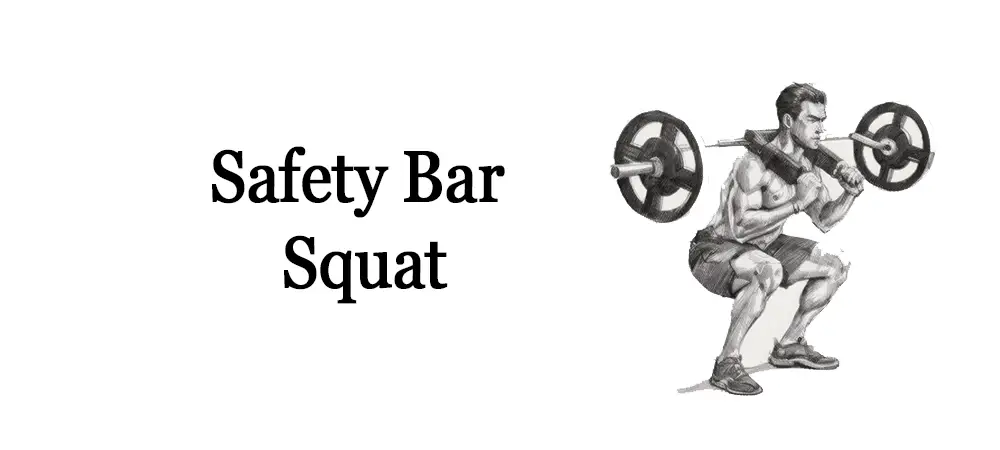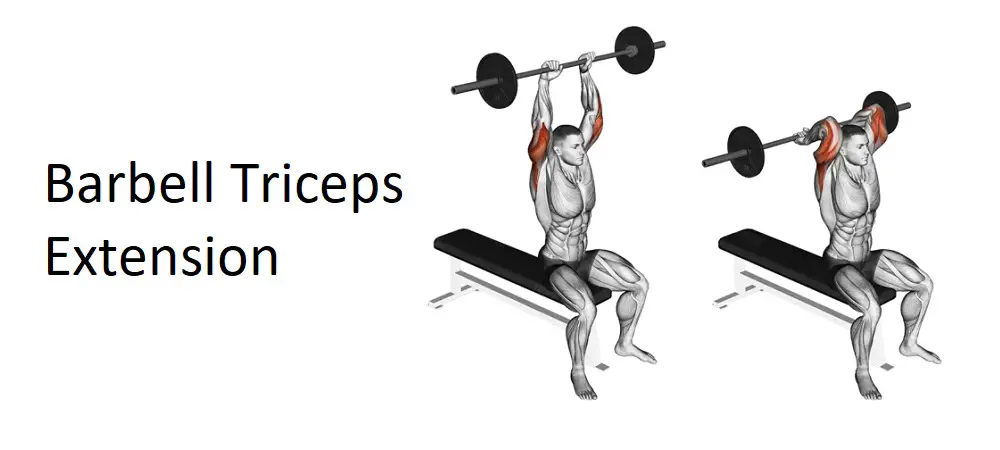Table of Contents
Introduction
The Safety Bar Squat is a variation of the traditional back squat that involves the use of a specialized safety bar with handles that are positioned in front of the lifter. This exercise provides a unique training stimulus while reducing stress on the shoulders, wrists, and elbows compared to the standard back squat. In this comprehensive guide, we’ll explore the correct technique, benefits, variations, and other essential details associated with the Safety Bar Squat.
Instructions
Setup:
- Bar Placement: Position the safety bar on the squat rack at an appropriate height. Ensure that the bar is stable and securely locked in place.
- Adjust Handles: Adjust the handles on the safety bar to a comfortable height and grip width. The handles should be positioned in front of the lifter, allowing for a neutral wrist and shoulder position.
Execution:
- Rack the Bar: Step under the safety bar and position it securely on your upper back, just below the base of your neck. Grip the handles firmly with an overhand grip.
- Stance: Stand with your feet shoulder-width apart or slightly wider, with your toes pointed slightly outward. Maintain a straight back and engage your core muscles.
- Descent: Inhale deeply and initiate the squat by bending at the hips and knees simultaneously. Lower your body under control, keeping your chest up and your knees tracking in line with your toes.
- Depth: Descend until your thighs are parallel to the ground or slightly below, ensuring that your hips are lower than your knees. Maintain tension in your muscles throughout the movement.
- Ascent: Exhale forcefully and drive through your heels to push yourself back up to the starting position. Keep your core tight and maintain a neutral spine as you rise.
- Lockout: Fully extend your hips and knees at the top of the movement, but avoid hyperextending your lower back. Squeeze your glutes to achieve full hip extension.
- Repeat: Perform the desired number of repetitions with controlled form, ensuring that each repetition maintains proper technique and depth.
Benefits
- Reduced Shoulder and Wrist Stress: The Safety Bar Squat reduces stress on the shoulders, wrists, and elbows compared to the standard back squat, making it a safer option for lifters with mobility or flexibility limitations.
- Increased Quadriceps and Glute Activation: The Safety Bar Squat places greater emphasis on the quadriceps and glutes compared to the standard back squat, making it an effective exercise for building lower body strength and muscle mass.
- Improved Core Stability: The front-loaded nature of the safety bar forces the lifter to engage their core muscles to maintain an upright posture throughout the movement, leading to improved core stability and strength.
- Enhanced Squat Mechanics: The neutral grip handles promote proper upper body positioning and spinal alignment, allowing lifters to perform the squat with optimal biomechanics and technique.
Variations
- Paused Safety Bar Squat: Perform the squat with a brief pause at the bottom position to increase time under tension and enhance strength and control.
- Safety Bar Box Squat: Perform the squat while sitting back onto a box or bench to limit depth and emphasize hip and glute activation.
Muscles worked in Safety Bar Squat
The Safety Bar Squat primarily targets the muscles of the lower body, including the quadriceps, glutes, hamstrings, and adductors. Additionally, several other muscle groups are engaged to stabilize the body and support proper form throughout the movement. The key muscles worked during the Safety Bar Squat include:
- Quadriceps: The quadriceps muscles, located at the front of the thighs, are heavily engaged during the squatting motion to extend the knee joint and straighten the legs. The Safety Bar Squat emphasizes quadriceps activation due to the more upright torso position compared to the traditional back squat.
- Gluteus Maximus: The gluteus maximus, the largest muscle of the buttocks, plays a significant role in hip extension during the ascent phase of the squat. The Safety Bar Squat targets the glutes to a high degree, particularly when performed with proper depth and activation.
- Hamstrings: The hamstrings, located at the back of the thighs, act as synergists during the squatting motion to assist in hip extension and knee flexion. They work in conjunction with the glutes to stabilize the hips and control the descent and ascent phases of the squat.
- Adductors: The adductor muscles of the inner thigh help stabilize the knees and contribute to maintaining proper alignment of the lower body during the squat. They are engaged isometrically to prevent the knees from collapsing inward during the movement.
- Erector Spinae: The erector spinae muscles, located along the spine, provide stabilization to the torso and help maintain an upright posture throughout the squat. They work to prevent forward or backward leaning and support the natural curvature of the spine.
- Core Muscles: The muscles of the core, including the rectus abdominis, obliques, and transverse abdominis, are engaged to stabilize the trunk and pelvis during the squatting motion. They help maintain proper spinal alignment and prevent excessive forward or backward tilting.
By targeting these muscles, the Safety Bar Squat effectively strengthens and develops the lower body, promoting improved strength, muscle hypertrophy, and functional movement patterns. It’s important to perform the exercise with proper form and technique to maximize muscle activation and minimize the risk of injury. Gradually increase the weight and intensity of the squat over time as you become more proficient with the movement. If you experience any discomfort or pain during the exercise, cease immediately and consult with a fitness professional or healthcare provider.
Alternate names for Safety Bar Squat
- Yoke Bar Squat
- SSB Squat (SSB stands for Safety Squat Bar)
- Hatfield Squat (named after powerlifter Fred Hatfield)
- Cambered Bar Squat
FAQs
What is a Safety Bar Squat?
The Safety Bar Squat is a variation of the traditional barbell squat where a special barbell, known as a safety squat bar, is used. This bar has handles in front and pads that rest on the shoulders, providing additional stability and comfort during the squat movement.
How do you perform a Safety Bar Squat?
Start by positioning yourself under the safety squat bar and securing it across your shoulders. Grip the handles in front of you with a comfortable grip width.
Stand with your feet shoulder-width apart or slightly wider, toes pointed slightly outward. Keep your chest up, back straight, and core engaged.
Lower yourself into a squat by bending at the hips and knees, pushing your hips back and down while keeping your chest up. Aim to descend until your thighs are parallel to the ground or slightly below.
Keep your knees in line with your toes and your weight centered over your midfoot. Avoid allowing your knees to collapse inward or your lower back to round.
Drive through your heels to push yourself back up to the starting position, fully extending your hips and knees.
Repeat for the desired number of repetitions.
Which muscles does the Safety Bar Squat target?
The Safety Bar Squat primarily targets the lower body muscles, including the quadriceps, hamstrings, glutes, and adductors. It also engages the core muscles and stabilizers to a significant degree due to the unique positioning of the bar.
What equipment is needed for the Safety Bar Squat?
You’ll need access to a safety squat bar, which is a specialized barbell designed for this exercise. Additionally, you’ll need an appropriate squat rack or power cage to perform the exercise safely.
What are the benefits of the Safety Bar Squat?
The Safety Bar Squat offers several benefits, including:
Reduced stress on the shoulders and wrists compared to traditional back squats, making it suitable for individuals with mobility or flexibility issues.
Increased comfort due to the padded shoulder rests and handles, allowing for a more upright torso position and potentially reducing lower back strain.
Enhanced activation of the quadriceps and glutes due to the forward positioning of the weight, promoting a more vertical torso angle during the squat.
Is the Safety Bar Squat suitable for beginners?
Yes, the Safety Bar Squat can be suitable for beginners, especially those who may struggle with mobility or wrist flexibility issues that make traditional back squats uncomfortable. However, it’s essential to start with lighter weights and focus on mastering proper form before progressing to heavier loads.
How many sets and reps should I do for the Safety Bar Squat?
The number of sets and reps can vary depending on your fitness goals, experience level, and overall workout routine. A typical range might be 3-4 sets of 8-12 repetitions.
Are there any safety considerations for the Safety Bar Squat?
As with any exercise, it’s crucial to use proper form and technique to reduce the risk of injury during the Safety Bar Squat. Ensure that the bar is securely positioned on your shoulders, and maintain a stable, upright torso throughout the movement. Additionally, start with lighter weights and gradually increase the load as you become more comfortable with the exercise.
Can the Safety Bar Squat help with building muscle and strength?
Yes, the Safety Bar Squat is an effective exercise for building lower body strength and muscle mass, particularly in the quadriceps, hamstrings, and glutes. By using heavier weights and progressive overload, you can stimulate muscle growth and strength gains over time.
Should I feel any discomfort during the Safety Bar Squat?
You may experience muscle fatigue or discomfort in the lower body muscles being worked, particularly the quads, hamstrings, and glutes. However, you should not feel sharp or shooting pain, especially in the knees or lower back. If you do, stop the exercise immediately and reassess your form or seek guidance from a fitness professional.
Conclusion
Incorporating the Safety Bar Squat into your lower body training routine can offer a variety of benefits, including reduced stress on the shoulders and wrists, increased quadriceps and glute activation, improved core stability, and enhanced squat mechanics. By mastering the proper technique and progressively overloading the muscles, you can experience significant improvements in lower body strength, muscle size, and overall performance. Remember to start with a light weight and focus on proper form to avoid injury. If you’re new to weightlifting or have any existing injuries or medical conditions, consult with a fitness professional or healthcare provider before attempting the Safety Bar Squat.
Also, check the Cable Pull-Downs
More reading on A Biomechanical Comparison of the Safety-Bar, High-Bar and Low-Bar Squat around the Sticking Region among Recreationally Resistance-Trained Men and Women.
Check our Home Page for the latest posts on exercises, travel, and more








